|
|
Advertisement:
|
|
Intel E8000 "Wolfdale" Dual-Core Processors |
|
Join the community - in the OCAU Forums!
|
How We Tested, Sandra, Gaming Results
HOW WE TESTED
To find out to what extent the changes implemented with Penryn translate into dual-core performance gains, we benchmarked an E8500 engineering sample. The E8500 is the E8000 series top model. In this capacity we compared it with an E6850, the previous top-of-the line product. However, the E8500 is running at 3160 MHz and the E6850 at 3000 MHz. This means that differences between them cannot be entirely attributed to the new features that come with the E8000 series, but at least partially to the 160 MHz higher core frequency. In order to “isolate” the impact of the various changes Intel has implemented with E8000 we run all tests with a multiplier of x9 as well. At 9x 333 MHz the engineering sample is emulating an E8400 processor with a default frequency of 3000 MHz. This is also the E6850 default frequency. All differences in performance, power consumption, heat dissipation, etc between an E8400 and an E6850 can be attributed to Wolfdale’s enhanced micro-architecture, its 50% larger L2 cache, and the 45nm transistor shrinkage. In addition we show the results for an AMD 6400+ processor as this is still the most powerful dual-core product AMD has to offer. We furthermore included a 45nm based QX9650. Results for both the X2 6400+ and the QX9650 are from our QX9650 review.
Intel CPU were tested with the P35 chipset based Asus P5K Deluxe and DDR2. The X2 6400+ was tested with an nForce 590 chipset based Asus M2N32-SLI motherboard. Identical RAM and peripherals were used for both test platforms. In some cases we did not use the latest driver or BIOS version. This is because we wanted to compare the results from our QX9650 review with the E8000 results in this review. For this reason we ran all E8000 tests with the same driver versions we had used for the QX9650 tests in November 2007.


SYNTHETIC BENCHMARKS BY SANDRA XIIC
SiSoftware “Sandra” CPU, multimedia, and memory benchmarks give us a first idea about the impact of Penryn’s 50% bigger L2 cache and enhanced micro-architecture. The CPU arithmetic benchmark shows the E8400 leading the QX6850 by around 2%. The floating point benchmark shows an advantage of 5%. Obviously this is the impact of the fast radix-16 divider unit. The multimedia CPU floating point benchmark has both CPUs performing head-to-head. The multimedia integer test takes advantage of the new SSE4.1 instructions. We see the E8400 with a substantial gain of 18%. Memory bandwidth improves by around 2% with the E8400, but is still far behind the X2 6400+ system. AMD’s on-die memory controller still plays in a league of its own when it comes to memory bandwidth.

GAMING
We selected 4 popular 3D-games for this test round: Team Fortress 2, Half Life 2 Episode 2, Lost Planet, and Supreme Commander. Detail level and image quality were set to their highest settings. Anti-aliasing was disabled.
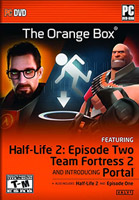 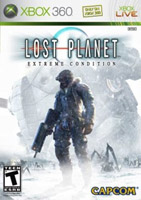 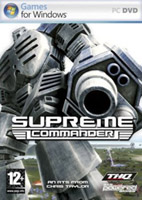
Team Fortress 2 is a first-person shooter game based on the “Source” engine and DirectX9. We recorded a short game session and played it back using the build-in time-demo function. At 1024x768 the E8400 is providing around 5% more frames per second than the E6850. At 1920x1200 the difference is negligible. The difference between the quad-core QX9650 and dual-core E8000 CPU is negligible. Vista’s “Task Manager” shows that TF2 is utilizing mainly 1 core only.
Half Life 2: Episode 2 is another first-shooter game based on the “Source” engine. We created a demo run and played it back with the “timedemo” command. The results shown are the average frame rates reported back to the console. At 1024x768 the E8400 provides around 15 frames per second more than the E6850. This is quite a big gain of 9%. In HL2 the dual-core E8500 seems to be a few frames per second faster than the QX9650. At 1920x1200 there is again basically no difference noticeable between the E6850 and both E8000 CPU.
“Lost Planet: Extreme Condition” is DirectX10 based and runs multithreaded. We enabled the game’s multi-core function for our test. The game has several built-in benchmarks; we are showing the results for “Cave”. This is the most demanding level, because it throws a high load of flying doo-dads and other details at the gamer making good use of the game’s multithread capability. At 1024x768 the E8400 is around 8% faster than the E6850. At lower resolutions a quad-core CPU offers a massive advantage in this game. At 1024x768 a QX9650 is providing more than double the number of frames per second in “Cave” than the dual-core CPU. Nonetheless, at 1920x1200 the difference between the tested CPU becomes largely negligible, because at such high resolution, frame performance is almost entirely driven by the graphic card.
Supreme Commander is a DirectX 9 based strategy game. We used the built-in FPS benchmark. The E8400 is besting the E6850 by 5% and both dual-core E8000 are very slightly faster than the QX9650. SP seems to be very much “GPU bound”, because even at 1024x768 the difference between the fastest and the slowest CPU is just 15%. Obviously a quad-core CPU does not offer any advantage in a GPU-bound game. At 1920x1200 the differences between the CPUs became zero, and the E8500 system performed no better than the otherwise slowest CPU, the X2 6400+.
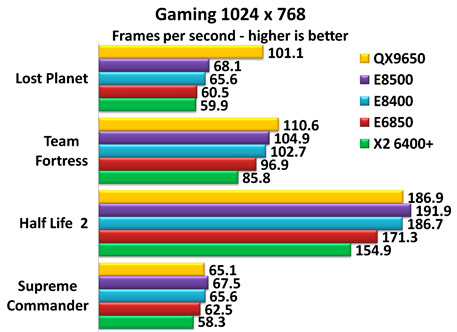
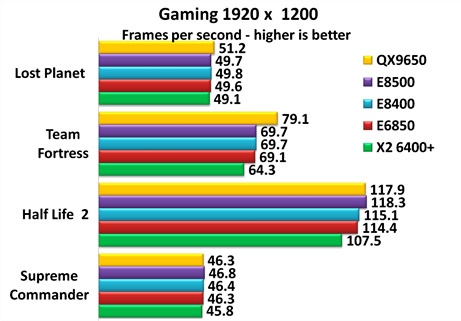
|
|
Advertisement:
All original content copyright James Rolfe.
All rights reserved. No reproduction allowed without written permission.
Interested in advertising on OCAU? Contact us for info.
|

|


